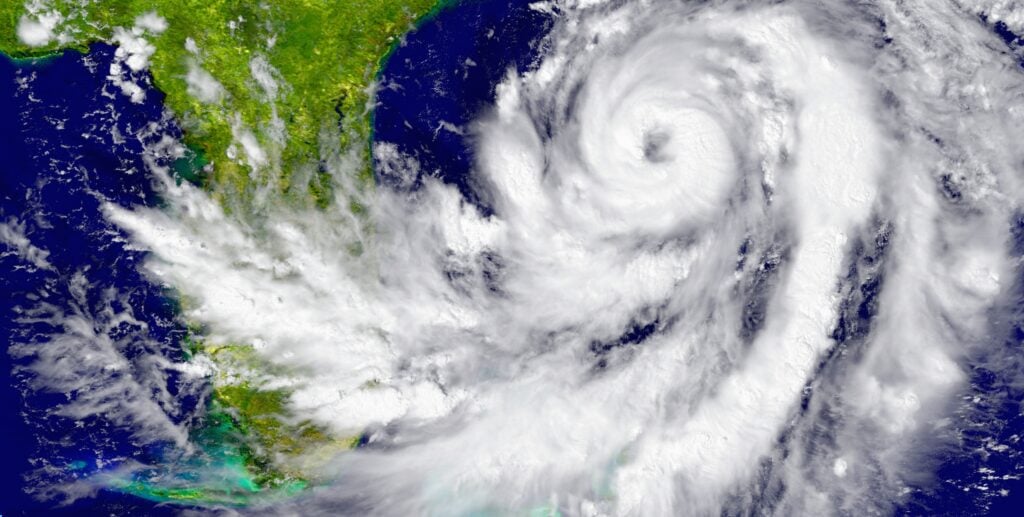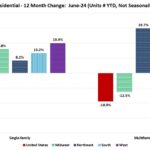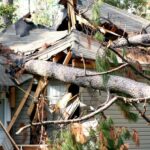The 2024 Atlantic hurricane season is beginning to ramp up. Hurricane Debby recently made landfall, bringing heavy rain and wind to parts of Florida, Georgia, and South Carolina. has started, and forecasts are not looking good.
The season is expected to be very busy and possibly top the record books for the number of storms named. The National Oceanic and Atmospheric Administration (NOAA) predicts there could be as many as 25 total storms, with eight to 13 becoming hurricanes.
Metro Areas Most at Risk of Hurricane and Storm Surges
According to analytics company CoreLogic, more than 32.7 million homes from Texas to Maine are at risk of hurricane damage this year.
While it’s impossible to know exactly who will be impacted this hurricane season, some areas could be harder hit than others, while not all homes will experience a total loss. Some could be damaged by flooding and storm surges, and others by wind.
CoreLogic’s 2024 Hurricane Risk Report identified the areas most at risk of damage from hurricane winds and storm surges. Areas with high population density in low-lying coastal areas are most at risk. However, how much a property could be damaged depends on various factors, such as elevation changes and any barriers to block water from moving inland.
It’s important to remember that while most initial damage occurs in coastal markets as the storms make landfall, the impacts can still be felt hundreds of miles away—either up the coast or inland. For example, Debby is expected to drop 20 to 25 inches of rain in some areas. Savannah, Georgia, and Charleston, South Carolina, each received more than a month’s worth of rain in just one day.
With that in mind, here’s a look at places with the most risk of damage from hurricane winds, as well as the reconstruction value from such phenomena.
| Metro Area | Number of homes at moderate or greater risk to hurricane winds | Reconstruction value (in billions) |
|---|---|---|
| New York, New York | 3,765,489 | $1.961 |
| Philadelphia, Pennsylvania | 1,657,757 | $703.6 |
| Houston, Texas | 2,092,308 | $671.3 |
| Boston, Massachusetts | 1,347,819 | $669.5 |
| Miami, Florida | 2,048,827 | $511.4 |
| Tampa, Florida | 1,107,320 | $294.5 |
| Providence, Rhode Island | 483,033 | $211.7 |
| Virginia Beach, Virginia | 583,928 | $186.4 |
| Jacksonville, Florida | 580,352 | $167.9 |
| Richmond, Virginia | 435,597 | $153.6 |
| Hartford, Connecticut | 353,537 | $150.3 |
| Bridgeport, Connecticut | 212,853 | $135.8 |
| New Orleans, Louisiana | 442,099 | $135.1 |
| North Port, Florida | 398,672 | $107.7 |
Many of the metro areas with the most at-risk homes also tend to be in areas that are familiar with hurricane damage. Hurricane Sandy, for example, caused an estimated $19 billion in damages and lost economic activity across New York City in 2012. As the most densely populated city in the U.S., it’s not a surprise that it tops the list of the most homes at risk of damage from storm surges and hurricane winds.
Here’s a look at those places most likely to see coastal flooding, as well as the reconstruction value.
| Number of homes at moderate or greater risk to storm surge | Reconstruction value (in billions) | |
|---|---|---|
| New York, New York | 878,226 | $415.4 |
| Virginia Beach, Virginia | 396,843 | $124.8 |
| Miami, Florida | 509,133 | $124.0 |
| Tampa, Florida | 448,013 | $109.5 |
| New Orleans, Louisiana | 320,908 | $99.3 |
| Cape Coral, Florida | 318,004 | $78.4 |
| North Port, Florida | 254,218 | $64.6 |
| Boston, Massachusetts | 148,005 | $59.5 |
| Naples, Florida | 196,454 | $54.9 |
| Charleston, South Carolina | 148,987 | $53.3 |
| Houston, Texas | 192,937 | $52.6 |
| Jacksonville, Florida | 154,177 | $46.1 |
| Philadelphia, Pennsylvania | 120,426 | $42.1 |
| Salisbury, Maryland | 138,295 | $40.9 |
Other metro areas, such as Miami and Houston, are also familiar with hurricanes. According to NOAA’s historical trackers, there have been 48 and 28 hurricanes within 60 nautical miles of Miami and Houston’s counties since the beginning of the 20th century.
How to Protect Your Property During Hurricane Season
For homeowners and real estate investors who own property in areas that are more prone to hurricane and storm damage, it’s essential to understand and know the risks these storms present to your property, Maiclaire Bolton-Smith, vice president of hazard and risk management at CoreLogic, told BiggerPockets. “When you know your risk, you can accelerate your recovery,” she added.
She added that the other key to preparing is to understand your insurance policy, knowing what is covered and what isn’t. For example, flood insurance is not mandatory unless the property is mortgaged and in a FEMA-designated flood zone. If a property is damaged by flooding and isn’t covered, you could end up footing the bill yourself.
“As we have seen from events like Hurricane Harvey in 2017, flooding damage can be extreme and often not limited to designated flood zones, so understanding what is covered is critical. That’s not something you want to find out after a home has sustained hurricane damage,” Bolton-Smith said.
Besides insurance, you can also fortify your home, such as making sure the roof is in good condition and there are no loose shingles, as well as ensuring there are no large trees or other items that could damage your home, she added.
Does It Still Make Sense to Buy In Areas Prone to Climate Disasters?
Hurricanes and other climate disasters have been more frequent and extreme in recent years. This increases the risk of potential property damage and costs—and has caused insurance premiums to skyrocket in many areas. And it seems that this trend will only get worse, with as many as 40 million homes at risk of a spike in insurance premiums.
“The reality is, risk of some kind is present in most places,” said Bolton-Smith. She lives in California, which faces both earthquake and wildfire risks. And while it’s unlikely a hurricane would hit every area mentioned in CoreLogic’s report, there is a chance of multiple disaster events in one year.
Still, technology and building codes have greatly improved to ensure that homes are fortified against risk, such as with magnesium siding or reinforced doors and windows.
Ultimately, “I think it comes down to understanding the potential risk and deciding whether you’re comfortable with it and knowing what resources you have to mitigate it,” Bolton-Smith said.
Ready to succeed in real estate investing? Create a free BiggerPockets account to learn about investment strategies; ask questions and get answers from our community of +2 million members; connect with investor-friendly agents; and so much more.
Note By BiggerPockets: These are opinions written by the author and do not necessarily represent the opinions of BiggerPockets.




